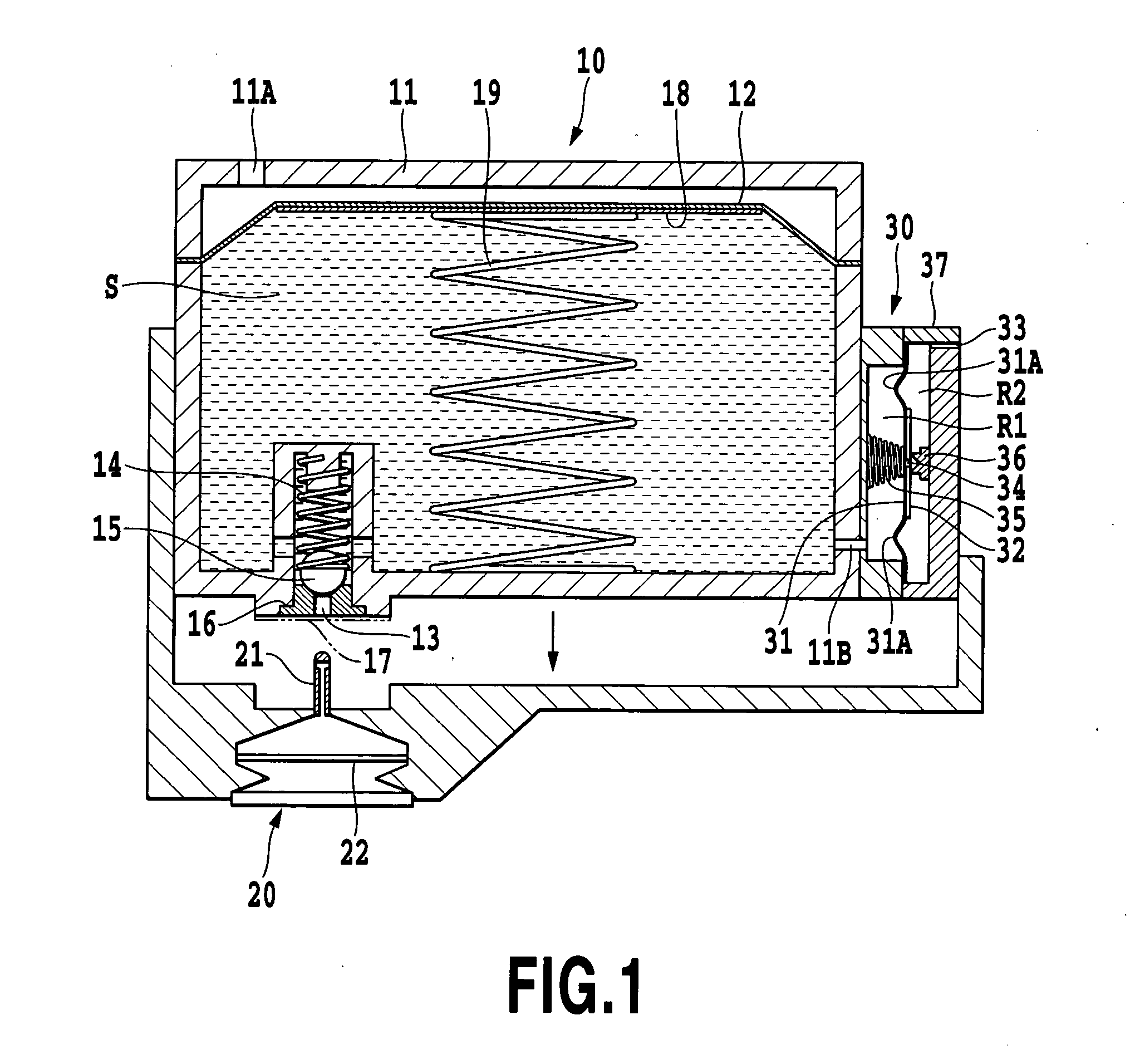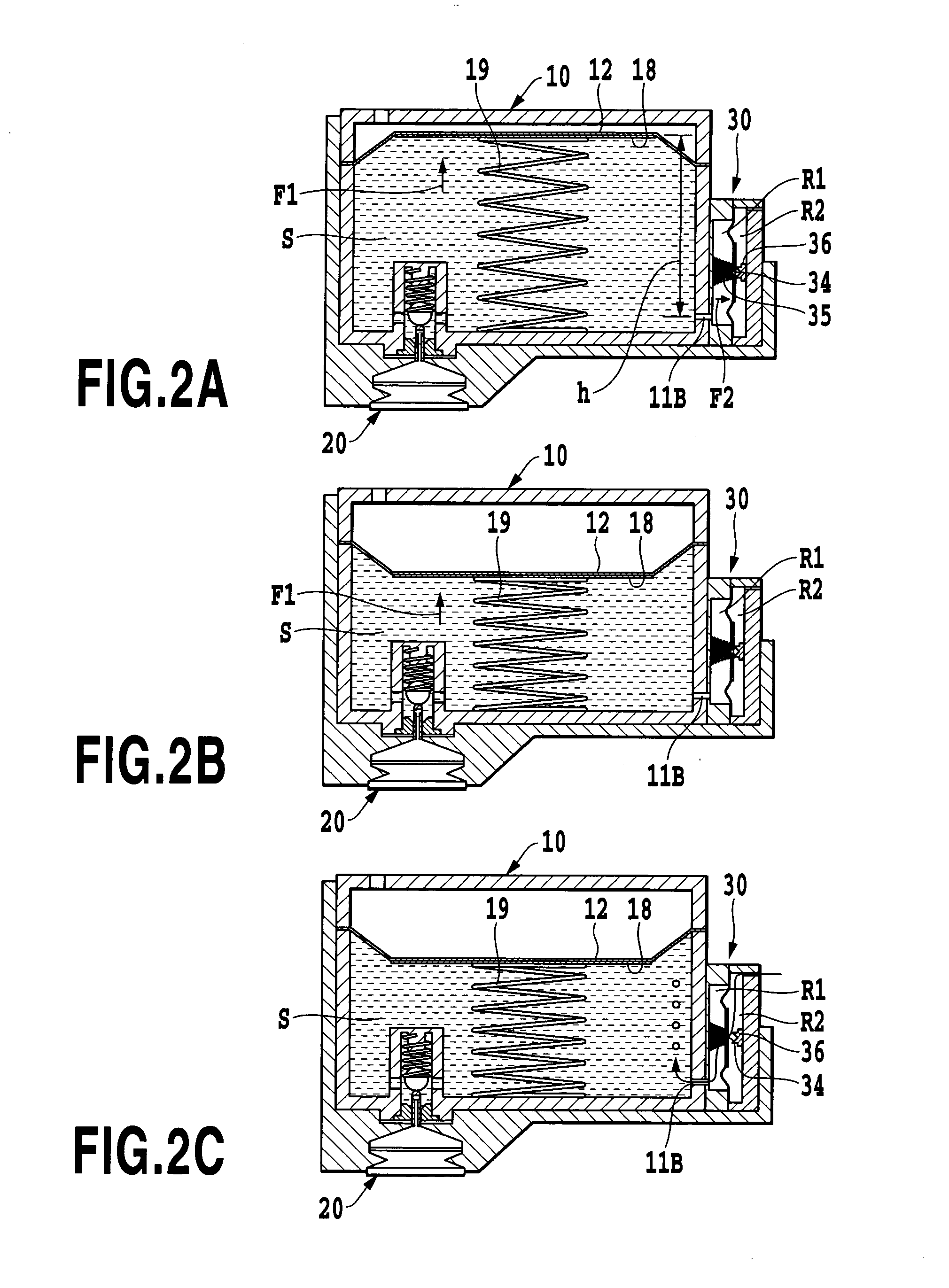With these negative
pressure generation mechanisms, however, the negative pressure generated tends to increase as the amount of ink remaining in an ink tank (bag-like member) decreases.
When the negative pressure exceeds a predetermined level, ink can no longer be supplied stably to a print head.
This gives rise to a possibility of the ink tank becoming unfit for use before the ink in the ink tank is completely consumed.
As a result, the negative pressure may increase in excess of an appropriate range that allows normal ink ejections from a print head, making it impossible for an adequate
meniscus to be formed at the ink ejection portions of the print head or to supply ink stably to the print head.
In this case, not all of the ink volume in the bag member cannot be used.
This kind of bag member, however, has a limitation on the shape.
Even with this bag member, when the ink is about to be used up, the negative pressure is so high as will cause a performance degradation in supplying ink to the print head or make the ink ejection operation of the print head unstable.
These negative pressure adjust mechanisms disclosed in U.S. Pat. Nos. 5,917,523, 5,600,358 and Japanese
Patent Application Laid-open No. 6-183023 (1994), however, all require a plurality of parts in the air take-in portion, rendering the construction that much complicated.
That is, the liquid seal in the orifice may be broken depending on various conditions, resulting in a leakage of accommodated ink.
The
humidity variations therefore make an air introducing operation unstable, which in turn may lead to a performance reduction in supplying ink to the print head and to a degraded quality of printed images.
The provision of the inlet maze, however, complicates the construction.
Further, since the other end of the inlet maze (maze-like path) communicates with
open air at all times, the ink unavoidably evaporates to some degree through this inlet maze.
There is another problem.
At this time, the inrush air may cause the ink remaining in the print head and the ink tank to leak out of nozzles or through the ring-shaped orifice in which the
meniscus has been broken.
When ink in the ink container is almost running out and a volume of air in the ink container is larger than that of ink, if the
atmosphere is introduced into the ink tank through the opening, the maintenance of a meniscus in the liquid-sealed opening of the container and in the ink
nozzle openings of the print head may become incomplete.
This in turn may cause an ink leakage and render the introduction of air incomplete.
Depending on a variety of conditions the liquid seal in the opening may be broken, resulting in an early introduction of air before the pressure in the ink container reaches a predetermined value or, conversely, a leakage of ink.
These conditions change depending on the design of the print head and ink tank and a
physical property of ink, so it is difficult to properly design a shape and dimensions of the opening.
The negative pressure adjust mechanisms using the liquid seal described above may also reduce a degree of freedom of design in the printing apparatus.
That is, it is difficult to form the liquid seal portion separate from the ink tank and then removably
mount it on the ink tank.
Refilling the tube with ink after the air introduction requires complicated
processing or construction.
As a result, the negative
pressure level at which the air introduction is executed may become unstable.
However, low-rigidity materials used for such a flexible sheet generally have a small thickness and a high gas permeability, so air can easily pass through it.
Thus, if ink is stored in the ink bag for a long period of time, a large volume of air, so large as cannot be dealt with by a buffer function originally intended to absorb an expanded portion of gas (air) in the ink bag, enters into the ink bag, rendering the buffer function ineffective.
It is therefore necessary to use a very expensive material deposited with a
metal vapor to meet both of the requirements of a low rigidity and a low gas permeability.
Thus, if the member is immersed in ink, component materials of the member may dissolved into the ink, degrading reliability of ink and printed images.
Further, characteristic changes of the member may render a correct pressure adjustment impossible.
This in turn shifts a timing at which the one-way valve 30 is operated, rendering the negative pressure in the
accommodation space S unstable.
 Login to View More
Login to View More  Login to View More
Login to View More 


